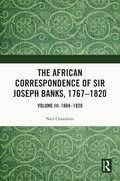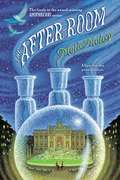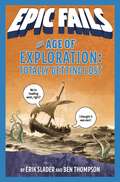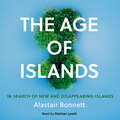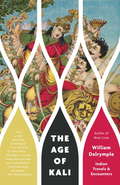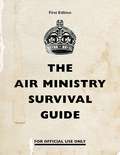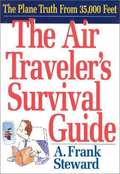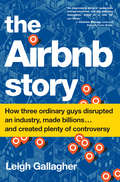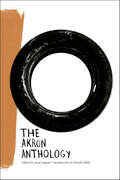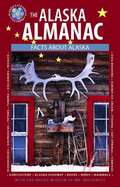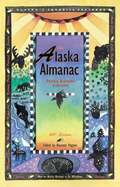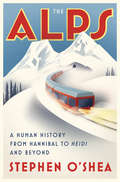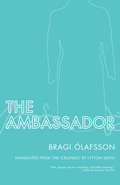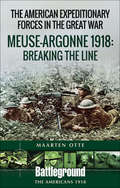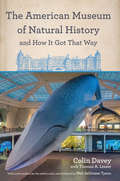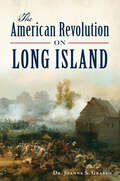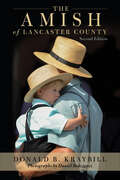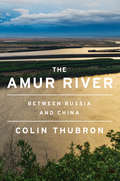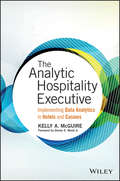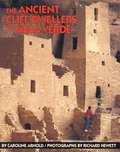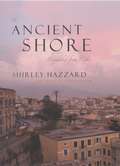- Table View
- List View
The African Correspondence of Sir Joseph Banks, 1767–1820: Volume III 1804–1820
by Neil ChambersThis edition brings together in three fully edited volumes the correspondence and associated papers of Sir Joseph Banks regarding European and especially British exploration of Africa from 1767–1820, for the first time publishing this globally scattered material in one place, thereby revolutionizing its availability and understanding of the activities of a key figure who helped organize and publish a series of missions to penetrate the African interior, mainly from West Africa and by crossing the Sahara from Cairo and Tripoli. Banks was a founder in 1788 of the African Association, which mounted many of these missions, including those of Mungo Park to explore the River Niger, and J.L. Burkhardt exploring Syria, Arabia and Egypt. At the time, little was known about the African interior, its peoples, kingdoms and resources, and the aim of the African Association under Banks was to discover what lay there, to make contact with and study its societies, to map them and their lands and help establish trading links. Banks also maintained a lively correspondence with British diplomatic representatives in North Africa, such as James Mario Matra at Tangier and Henry Salt in Cairo, who were a rich source of news. Moreover, as unofficial director of the royal gardens at Kew he sent pioneering plant collectors to gather plants in South Africa, vastly boosting knowledge of this region’s important flora. At home, he corresponded with politicians, government officials, entrepreneurs, navigators, naturalists and campaigners like William Wilberforce about a great range of issues surrounding Africa. This work is multi-disciplinary and will stand alongside existing series of Banks’s correspondence published by Neil Chambers (Scientific Correspondence, 2007; Indian and Pacific Correspondence, 2007–14). It will appeal to scholars of African history in the Early Modern Period, to those studying exploration and collecting as well as those interested in natural history, the history of science, geography, cartography and the Enlightenment. An Introduction, detailed Calendar of Correspondents, Timelines for each volume and a comprehensive Index supplement the footnotes to nearly 800 documents included in this fascinating and comprehensive new series.
The After-Room
by Maile Meloy Ian SchoenherrIt's 1955, and Benjamin Burrows and Janie Scott are trying to live a safe, normal life in America. It's not easy, when they have the power to prevent nuclear disaster, and sinister forces are circling. Soon the advice of a mysterious, unscrupulous magician propels Janie and Benjamin into danger, and toward the land of the dead. Meanwhile, their friend Jin Lo washes up on a remote island where an American spy is stationed, and finds herself on the trail of a deadly threat in China. But she's on the other side of the world--how can Janie and Benjamin reach her? The triumphant finale in the trilogy that began with Maile Meloy's bestselling, critically acclaimed The Apothecary, and continued in its captivating sequel, The Apprentices, The After-Room is full of enchantment and heart, with Ian Schoenherr's stunning illustrations throughout.From the Hardcover edition.
The Age of Exploration: Totally Getting Lost (Epic Fails #4)
by Ben Thompson Erik SladerChristopher Columbus is one of the most famous explorers of all time, but he was neither the first nor last adventurer to ever stumble upon a great discovery. From the Silk Road of Asia to the icy shores of Antarctica, our knowledge of the world today is in large part due to several intrepid pioneers, risking life and limb for the sake of exploration. After all, setting off into the dark unknown requires an enormous amount of bravery. But every explorer quickly learns that courage and curiosity aren’t enough to save you if you can’t read a map or trespass on somebody else’s land! In this fourth installment of the Epic Fails series, authors Erik Slader and Ben Thompson introduces readers to an international cast of trailblazers and details every mutiny, wrong turn, and undiscovered city of gold behind the age of exploration.
The Age of Islands: In Search of New and Disappearing Islands
by Alastair Bonnett'Extraordinary... A fascinating and intelligent book.' Sunday TimesNew islands are being built at an unprecedented rate whether for tourism or territorial ambition, while many islands are disappearing or fragmenting because of rising sea levels. It is a strange planetary spectacle, creating an ever-changing map which even Google Earth struggles to keep pace with.In The Age of Islands, explorer and geographer Alastair Bonnett takes the reader on a compelling and thought-provoking tour of the world's newest, most fragile and beautiful islands and reveals what, he argues, is one of the great dramas of our time.From a 'crannog', an ancient artificial island in a Scottish loch, to the militarized artificial islands China is building in the South China Sea; from the disappearing islands that remain the home of native Central Americans to the ritzy new islands of Dubai; from Hong Kong and the Isles of Scilly to islands far away and near: all have urgent stories to tell.
The Age of Kali
by William DalrympleFrom the author of The Last Mughal and Nine Lives: the classic stories he gathered during the ten years he spent journeying across the Indian subcontinent, from Sri Lanka and southern India to the North West Frontier of Pakistan. As he searched for evidence of Kali Yug, the "age of darkness" predicted by an ancient Hindu cosmology in a final epoch of strife and corruption, Dalrymple encountered a region that thrilled and surprised him. Venturing to places rarely visited by foreigners, he presents compelling portraits of a diverse range of figures--from a Hindi rap megastar through the Tamil Tigers to the drug lords of Pakistan. Dalrymple's love for the subcontinent comes across in every page, which makes its chronicles of political corruption, ethnic violence and social disintegration all the more poignant. The result is a dark yet vibrant travelogue, and a unique look at a region that continues to be marked by rapid change and unlimited possibilities as it struggles to reconcile the forces of modernity and tradition.
The Air Ministry Survival Guide (Air Ministry Survival Guide)
by AnonTHE ULTIMATE SURVIVAL GUIDE for anyone who thinks they'd survive the world's most hostile environments - or at least imagine they could do.-----------------------------First issued to British airmen in the 1950s the beautifully illustrated Air Ministry Survival Guide provides invaluable practical tips and instruction on how to keep calm and carry on in any hostile environment.Whether you're lost in the desert, arctic, jungle, or adrift on the open ocean, you'll be better off armed with sensible advice on how to:- Build a structurally sound igloo- Pull faces to prevent frostbite (and when to expect bits to fall off should you fail)- Fashion a mask to prevent snowblindness- Make a hat out of seat cushions- Behave in the event of meeting hostile locals- Stay safe from poisonous reptiles and insects- Use a 'fire thong'- Punch man-eating sharks (which are cowards)
The Air Traveler's Survival Guide: The Plane Truth from 35,000 Feet
by A. Frank StewardFrom the Book Jacket: Air travel may be crazy on the ground for passengers, but what's it really like at 35,000 feet for the cabin crew? How safe, for example, are you when you fly? Is airport security as good as they claim? Why are you more susceptible to the effects of alcoholic beverages at 35,000 feet? How common is the "Mile High Club"? Do the South Americans and Scandinavians behave differently in the air? A very Frank Steward answers these questions and countless more in The Air Traveler's Survival Guide, exposing all the warts and blemishes of air travel. You encounter a kaleidoscope of personalities and experiences, including an "enterprising stowaway rat, a woman who discarded all of her clothes, a passenger with a one-way ticket to death, a widow with her husband's ashes, a child who cuts the hair of a sleeping passenger, crew members' fertility problems, itchy and riotous layovers, and mass food poisoning 90 minutes from the nearest airport! Tucked among the 68 stories in The Air Traveler's Survival Guide is a trunkload of tips and advice on how to make the best of air travel, including: What to put in your carry-on bag How to upgrade your seat How to fly standby and save bundles of money How to decipher what crew members say How to minimize the effects of jet lag * How to select a hotel room in which you can sleep Appropriately dedicated to "the people who smile and thank you for your trash," this eye-opening book puts a whole new face on the travel industry. You will laugh and cry and at times grimace, but you'll also discover a rich tapestry of people who populate those crammed seats, crowded aisles, and tiny restrooms. While a lot may go wrong with air travel on the ground and in the air, when you travel with A. Frank Steward, you'll see through the eyes of the cabin crew what air travel is all about - transporting interesting, and often very demanding, strangers from one destination to another.
The Air-Conditioned Nightmare
by Henry MillerIn 1939, after ten years as an expatriate, Henry Miller returned to the United States with a keen desire to see what his native land was really like -- to get to the roots of the American nature and experience. He set out on a journey that was to last for three years, visiting many sections of the country and making friends of all descriptions. "The Air-Conditioned Nightmare" is the result of that odyssey.
The Airbnb Story: How Three Ordinary Guys Disrupted an Industry, Made Billions . . . and Created Plenty of Controversy
by Leigh Gallagher&“An engrossing story of audacious entrepreneurism and big-industry disruption, [this] is a tale for our times.&” —Charles Duhigg, New York Times–bestselling author of The Power of Habit An investigative look into a beloved, disruptive, notorious start-up, this is the remarkable behind-the-scenes story of the creation and growth of Airbnb, the online lodging platform that is now the largest provider of accommodations in the world. At first just the wacky idea of cofounders Brian Chesky, Joe Gebbia, and Nathan Blecharczyk, Airbnb has become indispensable to millions of hosts and travelers around the globe. Fortune editor Leigh Gallagher presents the first nuanced, in-depth look at the Airbnb phenomenon—the successes and controversies alike—and takes us behind the scenes as the company&’s young CEO steers into increasingly uncharted waters. &“A fast-paced, fun dive into one of the seminal firms of our time; through the tale of Airbnb, Leigh Gallagher shows us how the sharing economy can be a force for emotional connection—as well as for social and business disruption.&” —Rana Foroohar, Financial Times columnist and CNN global economic analyst
The Akron Anthology (Belt City Anthologies)
by David Giffels Jason Segedy Joanna RichardsAn evocative collection of essays, poetry, photography and more from some of Akron, Ohio&’s best authors, artists, and activists. Between 1910 and 1920, Akron, Ohio, tripled in size, making it the fastest growing city in the United States. Its period of rapid growth coincided with the expansion of the rubber and tire industry, which in turn corresponded with the automobile boom. But since the mid-1970s, industry has abandoned Akron, and the city has lost thirty-one percent of its population. Once-opulent neighborhoods are now swaths of abandoned homes, and the factories that made Akron the Rubber Capital of the World lie dormant. Edited by Jason Segedy, and bringing together established writers like Rita Dove and David Giffels with the work of emerging voices, The Akron Anthology collects essays, poems, and photographs from the writers, artists, and activists who call Akron home. Here you&’ll find stories that include: The diaries of a doorman The trials and triumphs of refugees who have relocated to the city A portrait of Jamie Stillman, world-renowned effects pedal manufacturer Archie the talking snowman.
The Alaska Almanac: Facts about Alaska
by Nancy Gates WhitekeysThe Alaska Almanac is an indispensable reference for those who are traveling to the north or those who already know and love it but want to impress others with their encyclopedic knowledge of Alaska's fascinating past and present. Updated each year, this affordable, best-selling guide offers accurate, timely facts on geography, history, economy, employment, recreation, trophy records, climate, and people of the state with the most ever largest lake, tallest mountain, longest coastline, biggest cabbage, most acreage in national parks and more. It also features Alaska's funniest man, Mr. Whitekeys, who manages to find some of the more bizarre facts about the state for us.
The Alaska Almanac: Facts about Alaska (24th edition)
by Rosanne PaganoAlaskans rank No. 1 in the nation in attainment of high-school degrees, No. 1 in ownership of Harley Davidson motorcycles, No. 1 in consumption of ice cream, and Alaskans are the second-highest per capita consumers of SPAM in the nation. To top it off, the makers of Itch-X anti-itch gel, named Wasilla "The 17th Itchiest City in the United States." Life has been good to Alaska for another year.
The Alps: A Human History from Hannibal to Heidi and Beyond
by Stephen O'SheaA thrilling blend of contemporary travelogue and historical narrative about the Alps from “a graceful and passionate writer” (Washington Post). For centuries the Alps have seen the march of armies, the flow of pilgrims and Crusaders, the feats of mountaineers, and the dreams of engineers?and some 14 million people live among their peaks today. In The Alps, Stephen O’Shea takes readers up and down these majestic mountains, battling his own fear of heights to journey through a 500-mile arc across France, Italy, Switzerland, Liechtenstein, Germany, Austria, and Slovenia. O’Shea, whose style has been hailed for its “engaging combination of candid first-person travel writing and absorbing historical narrative” (Chicago Sun-Times), whisks readers along more than 2,000 years of Alpine history. As he travels pass-by-pass through the mountains, he tells great stories of those (real and imagined) who have passed before him, from Hannibal to Hitler, Frankenstein’s monster to Sherlock Holmes, Napoleon to Nietzsche, William Tell to James Bond. He explores the circumstances behind Hannibal and his elephants’ famous crossing in 218 BCE; he reveals how the Alps have profoundly influenced culture from Heidi to The Sound of Music; and he visits iconic sites, including the Reichenbach Falls, where Arthur Conan Doyle staged Sherlock Holmes’s death scene with Professor Moriarty; Caporetto, the bloody site of the Italians’ retreat in World War I; and the Eagle’s Nest, Hitler’s aerie of a vacation home. O’Shea delves into Alpine myths and legends, such as the lopsided legs of the dahu, the fictitious goatlike creature of the mountains, and reveals why the beloved St. Bernard dog is so often depicted with a cask hanging below its neck. Throughout, he immerses himself in the communities he visits, engagingly recounting his adventures with contemporary road trippers, watchmakers, salt miners, cable-car operators, and yodelers.
The Ambassador
by Bragi Ólafsson Lytton SmithSturla Jón Jónsson is invited to represent Iceland at a poetry festival in Lithuania, which is the beginning of his troubles. While at the conference, his overcoat is stolen, his article about how stupid literary festivals are causes a huge controversy, and he's accused of plagiarism. And that doesn't even include his encounters with the bizarre festival attendees.
The American Craft Beer Cookbook: 155 Recipes from Your Favorite Brewpubs and Breweries
by John HollOpen a cold one and get cooking! Showcasing the diverse ways that beer can be used to enhance a meal, either as an ingredient or by pairing, John Holl’s collection of 155 tasty recipes are designed for the beer-loving foodie. From twists on traditional favorites like American Wheat Bear Steamed Clams to unexpected surprises like Chocolate Jefferson Stout Cupcakes, you’ll soon be amazing your friends with the culinary versatility of your favorite beverage.
The American Expeditionary Forces in the Great War: Meuse Argonne 1918: Breaking the Line (Battleground The Americans 1918)
by Maarten Otte&“An invaluable and extraordinary&” account of the bloodiest battle in American military history (Midwest Book Review). Although the Meuse-Argonne Offensive, which began in late September 1918 and continued through to the Armistice, was not the first major action fought by the AEF, it was the greatest in which it engaged in the Great War. The Argonne was an area that had been heavily fought over, particularly in the early part of the war; its eastern part, towards the Meuse, then became enveloped in the first great attritional battle of the war, Verdun. Maarten Otte gives a background narrative to events before the opening of the Offensive and its development. Taking each of the US corps in turn, he then provides tours that will help the visitor to understand the fighting and the problems that were faced. This opening book on the Meuse-Argonne takes the reader, more or less, to the date when General Pershing handed over command of the US First Army to Major General Liggard in mid-October, a change in command that marked a significant improvement in the American performance as they pushed the Germans ever backwards. The Great War battlefield of the Argonne is marked by numerous physical remains of the war, some fine (some might argue overly grandiose) monuments and by the stunning American cemetery at Romagne, the second largest in the world administered by the American Battle Monuments Commission. There is much to see in a battlefield that has been largely neglected in the decades since the Second World War.
The American Museum of Natural History and How It Got That Way: With a New Preface by the Author and a New Foreword by Neil deGrasse Tyson
by Colin DaveyThe American Museum of Natural History is one of New York City’s most beloved institutions, and one of the largest, most celebrated museums in the world. Since 1869, generations of New Yorkers and tourists of all ages have been educated and entertained here. Located across from Central Park, the sprawling structure, spanning four city blocks, is a fascinating conglomeration of many buildings of diverse architectural styles built over a period of 150 years. The first book to tell the history of the museum from the point of view of these buildings, including the planned Gilder Center, The American Museum of Natural History and How It Got That Way contextualizes them within New York and American history and the history of science. Part II, “The Heavens in the Attic,” is the first detailed history of the Hayden Planetarium, from the museum’s earliest astronomy exhibits, to Clyde Fisher and the original planetarium, to Neil deGrasse Tyson and the Rose Center for Earth and Space, and it features a photographic tour through the original Hayden Planetarium. Author Colin Davey spent much of his childhood literally and figuratively lost in the museum’s labyrinthine hallways. The museum grew in fits and starts according to the vicissitudes of backroom deals, personal agendas, two world wars, the Great Depression, and the Cold War. Chronicling its evolution―from the selection of a desolate, rocky, hilly, swampy site, known as Manhattan Square to the present day―the book includes some of the most important and colorful characters in the city’s history, including the notoriously corrupt and powerful “Boss” Tweed, “Father of New York City” Andrew Haswell Green, and twentieth-century powerbroker and master builder Robert Moses; museum presidents Morris K. Jesup, Henry Fairfield Osborn, and Ellen Futter; and American presidents, polar and African explorers, dinosaur hunters, and German rocket scientists. Richly illustrated with period photos, The American Museum of Natural History and How It Got That Way is based on deep archival research and interviews.
The American Revolution on Long Island (Military)
by Dr. Joanne S GrassoA history of the Revolutionary War and British occupation in this part of New York, from the Culper spy ring to the prison ships where thousands died. The American Revolution sharply divided families and towns on New York&’s Long Island. Washington's defeat at the Battle of Long Island in August 1776 started seven years of British occupation—and Patriot sympathizers were subject to loyalty oaths, theft of property, and the quartering of soldiers in their homes. Those who crossed the British were jailed on prison ships in Wallabout Bay in Brooklyn, where an estimated eleven thousand people died of disease and starvation. Some fought back with acts of sabotage and espionage—and Washington&’s famed Culper spy ring in Oyster Bay, Setauket, and other areas successfully tracked British movements. In this book, historian Joanne S. Grasso explores the story of an island at war.
The Amish of Lancaster County (Stackpole Military History Series)
by Donald B Kraybill&“Reveals the heart and soul of the Amish culture. This is the best introduction to Lancaster&’s Amish community.&” —Steven M. Nolt, author of A History of the Amish More than eight million people visit Lancaster County, Pennsylvania, every year to experience the culture of the oldest Amish community in the world. This book by the leading scholar of the Amish explains the uncommon lifestyle of these simple-living people who intrigue so many visitors. Mini-essays on all aspects of Amish life, from dress and spirituality to horse-and-buggy transport, are accompanied by beautiful full-color photographs. The author also discusses myths about the Amish, their selective use of technology, the recent media attention to Rumspringa, and the tragedy at the Nickel Mines school.
The Amur River: Between Russia and China
by Colin ThubronThe most admired travel writer of our time—author of Shadow of the Silk Road and To a Mountain in Tibet—recounts an eye-opening, often perilous journey along a little known Far East Asian river that for over a thousand miles forms the highly contested border between Russia and China.The Amur River is almost unknown. Yet it is the tenth longest river in the world, rising in the Mongolian mountains and flowing through Siberia to the Pacific. For 1,100 miles it forms the tense border between Russia and China. Simmering with the memory of land-grabs and unequal treaties, this is the most densely fortified frontier on earth. In his eightieth year, Colin Thubron takes a dramatic journey from the Amur’s secret source to its giant mouth, covering almost 3,000 miles. Harassed by injury and by arrest from the local police, he makes his way along both the Russian and Chinese shores, starting out by Mongolian horse, then hitchhiking, sailing on poacher’s sloops or travelling the Trans-Siberian Express. Having revived his Russian and Mandarin, he talks to everyone he meets, from Chinese traders to Russian fishermen, from monks to indigenous peoples. By the time he reaches the river’s desolate end, where Russia’s nineteenth-century imperial dream petered out, a whole, pivotal world has come alive. The Amur River is a shining masterpiece by the acknowledged laureate of travel writing, an urgent lesson in history and the culmination of an astonishing career.
The Analytic Hospitality Executive: Implementing Data Analytics In Hotels And Casinos (Wiley And Sas Business Ser.)
by Kelly A. Mcguire Dexter E. Wood Jr.Targeted analytics to address the unique opportunities in hospitality and gaming The Analytic Hospitality Executive helps decision makers understand big data and how it can drive value in the industry. Written by a leading business analytics expert who specializes in hospitality and travel, this book draws a direct link between big data and hospitality, and shows you how to incorporate analytics into your strategic management initiative. You'll learn which data types are critical, how to identify productive data sources, and how to integrate analytics into multiple business processes to create an overall analytic culture that turns information into insight. The discussion includes the tools and tips that help make it happen, and points you toward the specific places in your business that could benefit from advanced analytics. The hospitality and gaming industry has unique needs and opportunities, and this book's targeted guidance provides a roadmap to big data benefits. Like most industries, the hospitality and gaming industry is experiencing a rapid increase in data volume, variety, and velocity. This book shows you how to corral this growing current, and channel it into productive avenues that drive better business. Understand big data and analytics Incorporate analytics into existing business processes Identify the most valuable data sources Create a strategic analytic culture that drives value Although the industry is just beginning to recognize the value of big data, it's important to get up to speed quickly or risk losing out on benefits that could drive business to greater heights. The Analytic Hospitality Executive provides a targeted game plan from an expert on the inside, so you can start making your data work for you.
The Ancient Cliff Dwellers of Mesa Verde
by Caroline ArnoldDiscusses the Native Americans known as the Anasazi, who migrated to southwestern Colorado in the first century A.D. and mysteriously disappeared in 1300 A.D. after constructing extensive dwellings in the cliffs of the steep canyon walls. For children.
The Ancient Shore: Dispatches from Naples
by Shirley Hazzard Francis SteegmullerFor Hazzard and her husband, both insatiable readers, the Naples of Pliny, Gibbon, and Auden is constantly alive to them in the present. And in "The Ancient Shore", Hazzard is our guide, as we encounter Henry James, Oscar Wilde, and of course Goethe, but her concern is primarily with the Naples of our own time -- often violently unforgiving to innocent tourists, but able to transport the visitor who attends patiently to its rhythms and history. A town shadowed by both the symbol and the reality of Vesuvius can never fail to acknowledge the essential precariousness of life -- nor, as the lover of Naples discovers, the human compassion, generosity, and friendship that are necessary to sustain it.
